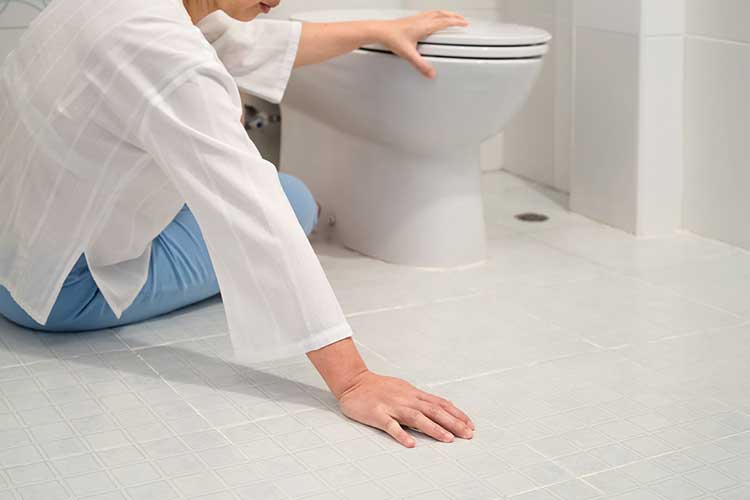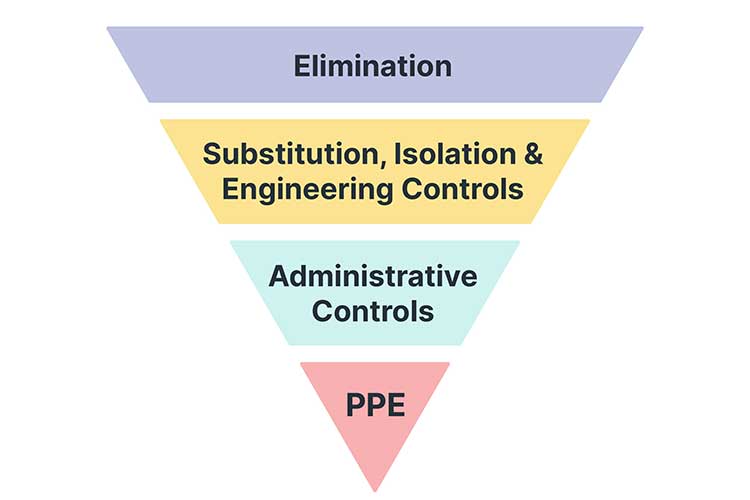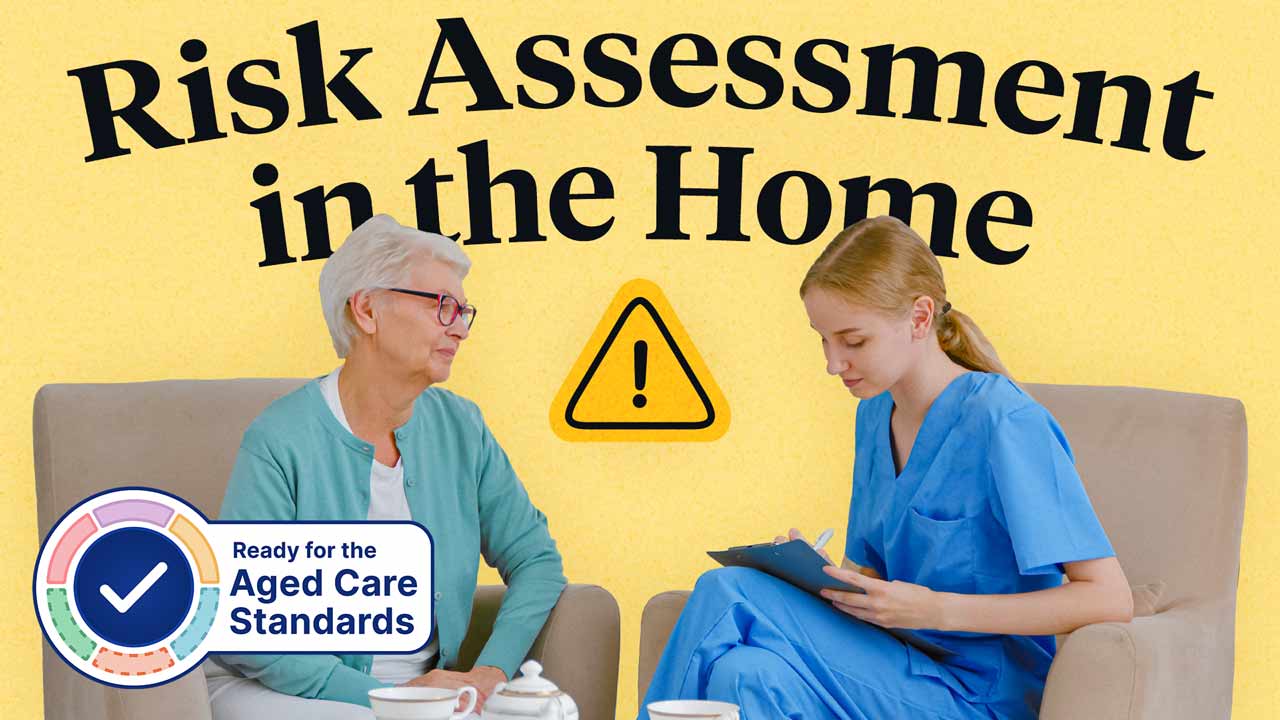Most injuries are preventable, but despite this, there were 538,000 injury hospitalisations in Australia in 2021-22 (AIHW 2023).
Alarmingly, the most likely location for accidents resulting in injury to occur is in the home (RoSPA 2015).
As a home care worker, you must be vigilant when working in client residences in order to minimise the risk of injury or harm to yourself and others. Consider that:
- 45% of home care workers have experienced an injury in the workplace
- More than half of emergency department presentations of older adults over 65 are for accidents that occurred in the home
- More than half of fall hospitalisations for older adults over 65 are for accidents that occurred in the home
- About 15% of fall-related injuries in older adults over 65 are caused by household objects (e.g. beds, chairs, stairs).
(Skatssoon 2019; PropertySafe 2017; Liotta 2019)
An essential component of home care is conducting risk assessments. You must know how to identify potential hazards, assess the risks they pose and implement appropriate control measures (Workplace Health and Safety Queensland 2018).
This will help ensure that you, your clients, your clients’ carers and other workers are safe in home environments (Workplace Health and Safety Queensland 2018).

Risk Assessment and Management in a Client’s Home Under the Strengthened Aged Care Quality Standards
Standard 4: The Environment - Outcome 4.1a: Environment and equipment at home under the strengthened Aged Care Quality Standards (Action 4.1.1a) requires aged care providers delivering care and services in a client’s home to recognise and mitigate any environmental risks to an older person’s safety (ACQSC 2024).
What is Risk Management?
Risk management is the process of identifying, assessing and controlling risks. It should be a proactive, planned and systematic process that addresses all potential hazards and risks in the workplace. Risk assessment is not a once-off task; it should be an ongoing process that responds to changes in the workplace and allows for continuous improvement. It should also be performed before undertaking any hazardous work activities (Safe Work Australia 2018).
The Risk Management Process
There are four steps in the risk management process:
- Identify hazard
- Assess risks
- Control risks
- Review control measures.
(Safe Work Australia 2018)
Risk management should be conducted together with the client, and any control measures should be implemented as part of their care or service plan (Workplace Health and Safety Queensland 2018).
1. Identify Hazards
Hazards are any objects or situations that have the potential to cause harm. In home care settings, hazards might arise from the client’s physical home environment; the equipment, materials and substances being used; or the work activities you are performing. Some hazards may be an inevitable part of your work, but others may be the result of accidents or failures (Safe Work Australia 2018).
The following table outlines some examples of hazards you might encounter in home care settings:
| Type of Hazard | Examples | Potential harm |
|---|---|---|
| Gravity (hazards that cause a person to fall or have something fall onto them) |
|
|
| Chemical and biological |
|
|
| Energy sources |
|
|
| Extreme temperatures |
|
|
| Machinery and equipment |
|
|
(WorkSafe Victoria 2017; Safe Work Australia 2018; Workplace Health and Safety Queensland 2018)
2. Assess Risks

Once a hazard has been identified, the next step is to conduct a risk assessment. This will help you to determine the overall severity of the risk, whether existing control measures are effective, whether you need to take any further action, and how urgently further actions should be taken (Safe Work Australia 2018).
Note: If the particular risk is already well-known, with established control measures, a formal risk assessment may not be necessary (Safe Work Australia 2018).
Ask the following three questions:
1. How severe would the potential harm be?
- What harm could occur as a result of the hazard? (e.g. injury, illness, death)
- Are there any other factors that could influence the severity of potential harm? (e.g. the distance of a fall)
- How many people could be harmed?
- Are there any situations that could increase the severity of an accident?
2. How could harm occur?
- What sequence of events could lead to harm occurring?
- Can one or more of the events in the sequence be stopped or changed?
3. What is the likelihood of harm occurring?
- Is it certain, very likely, likely, unlikely or rare?
- How often does the hazard have the potential to cause harm?
- How effective are current control measures (if any) in reducing the risk?
- Could differences in operating conditions increase the risk?
- Does the working environment increase the risk?
- If harm occurs, how long would people be exposed to it for?
- Could the likelihood be affected by the way people act or behave?
- Does the likelihood depend on the people involved?
(WorkSafe Victoria 2017)
The Hierarchy of Control Measures

The hierarchy of control measures lists different types of control measures from most to least reliable. You should always aim for elimination, as it offers the highest level of protection and is most effective in reducing the risk of harm. However, if elimination is not feasible, you should work your way down the hierarchy until you find the next best option (Safe Work Australia 2018).
Keep in mind that the lower levels of the hierarchy are less effective because without eliminating the hazard, there is no way to completely eliminate the risk. Even if you are able to minimise the risk, it will still exist in some capacity (Safe Work Australia 2018).
As a general rule:
- Eliminating the risk is most effective.
- Changing the risk to minimise it is less effective.
- Changing how people behave and expose themselves to the risk is least effective.
(WorkSafe Victoria 2017)
Elimination
Elimination involves completely removing the hazard and its associated risks.
This can be achieved through:
- Not introducing the hazard in the first place
- Removing the hazard (e.g. disposing of a hazardous object, refraining from going to a hazardous place).
(Safe Work Australia 2018)
Substitution, Isolation or Engineering Controls
The next best option is to either:
- Substitute the hazard with a safer alternative
- Physically isolate the hazard from people, or
- Implement an engineering control (mechanical device or process) to reduce the risk (e.g. a trolley to move heavy objects).
(Safe Work Australia 2018)
Administrative Controls
Administrative controls are work methods or procedures that aim to minimise exposure to the hazard and provide appropriate information, training and instruction to staff. Examples include implementing new policies or using signs to warn people about a hazard (Safe Work Australia 2018).
Personal Protective Equipment (PPE)
PPE should be used to reduce any remaining risks. It must be used and worn correctly in order to be effective (Safe Work Australia 2018).
4. Review Control Measures
The final stage of the risk management process is to regularly check that control measures are working effectively. Control measures should be reviewed:
- When they are not working effectively
- Before changes that may cause new or different risks to arise
- When new hazards or risks emerge
- When a review is indicated or requested.
(Safe Work Australia 2018)
The Risk Management Process in Practice

Scenario: You are a home carer for Greta, a 78-year-old woman who lives alone. During one of your visits, you notice that the shower in Greta’s bathroom is leaking, causing the bathroom floor to become wet and slippery.
1. Identify Hazard
In this case, the hazard has been identified as the shower leak.
2. Assess Risk
In order to assess the risk, you now need to ask the following questions:
| How severe would the potential harm be? |
|
| How could harm occur? |
|
| What is the likelihood of harm occurring? |
|
3. Control Risk
Using the hierarchy of control, you should now determine your options for controlling the risk.| Elimination | This is not possible, as Greta needs a shower in her home. |
|
|
| Administrative Controls | You could put a wet floor sign in Greta’s bathroom whenever you notice that the shower has leaked. |
| PPE | Greta could wear slip-resistant footwear in the bathroom. |
The best option here appears to be substituting the hazard with a safer alternative by having the shower repaired. While the shower cannot be eliminated completely, fixing it will hopefully ensure that there is no more water leakage onto the floor.
4. Review Control Measures
Once the shower has been repaired, you should check the bathroom floor during your visits to ensure that there is no more leakage.
Test Your Knowledge
Question 1 of 3
True or false: Some hazards are inevitable.
Topics
Further your knowledge
 Free
Free Free
Free Free
FreeReferences
- Aged Care Quality and Safety Commission 2024, Standard 4: The Environment, Australian Government, viewed 9 May 2024, https://www.health.gov.au/resources/publications/strengthened-aged-care-quality-standards-august-2025?language=en/environment
- Australian Institute of Health and Welfare 2023, Injury in Australia, Australian Government, viewed 5 September 2023, https://www.aihw.gov.au/reports/injury/injury-in-australia/contents/injury-overview
- Liotta, M 2019, ‘Falls the Cause of 75% of Injury Hospitalisations for Older People’, NewsGP, 19 September, viewed 5 September 2023, https://www1.racgp.org.au/newsgp/clinical/falls-the-cause-of-three-quarters-of-all-hospitali
- PropertySafe 2017, Home Injury Statistics, PropertySafe, viewed 5 September 2023, https://www.propertysafe.com.au/about-us/home-injury-statistics/
- Royal Society for the Prevention of Accidents 2015, Home Safety: Facts and Figures, RoSPA, viewed 5 September 2023, https://www.rospa.com/Home-Safety/Advice/General/Facts-and-Figures
- Safe Work Australia 2018, Model Code of Practice: How to Manage Work Health and Safety Risks, Safe Work Australia, viewed 5 September 2023, https://www.safeworkaustralia.gov.au/doc/model-code-practice-how-manage-work-health-and-safety-risks
- Skatssoon, J 2019, ‘Home Care Workers Suffering Abuse, Injuries’, Australian Ageing Agenda, 17 October, viewed 5 September 2023, https://www.australianageingagenda.com.au/executive/home-care-workers-suffering-abuse-injuries/
- Workplace Health and Safety Queensland 2018, A Guide to Working Safely in People’s Homes, Queensland Government, viewed 5 September 2023, https://www.worksafe.qld.gov.au/__data/assets/pdf_file/0018/82503/community-working-safely-in-peoples-homes.pdf
- WorkSafe Victoria 2017, Controlling OHS Hazards and Risks, Victoria State Government, viewed 5 September 2023, https://content.api.worksafe.vic.gov.au/sites/default/files/2018-06/ISBN-Controlling-OHS-hazards-and-risks-handbook-2017-06.pdf
 New
New 
